
Muhi-ud-Din Muhammad, commonly known by the sobriquet Aurangzeb or by his regnal title Alamgir, was the sixth Mughal emperor, who ruled over almost the entire Indian subcontinent for a period of 49 years. Widely considered to be the last effective ruler of the Mughal Empire, Aurangzeb compiled the Fatawa-e-Alamgiri, and was among the few monarchs to have fully established Sharia law and Islamic economics throughout the Indian subcontinent. He was an accomplished military leader whose rule has been the subject of praise, though he has also been described as the most controversial ruler in Indian history.

The Delhi Sultanate was an Islamic empire based in Delhi that stretched over large parts of the Indian subcontinent for 320 years (1206–1526). Five dynasties ruled over the Delhi Sultanate sequentially: the Mamluk dynasty (1206–1290), the Khalji dynasty (1290–1320), the Tughlaq dynasty (1320–1414), the Sayyid dynasty (1414–1451), and the Lodi dynasty (1451–1526). It covered large swathes of territory in modern-day India, Pakistan, Bangladesh as well as some parts of southern Nepal.
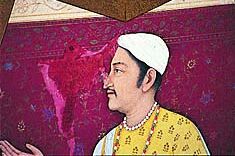
Tansen, also referred to as Tan Sen or Ramtanu Pandey, was a prominent figure of Hindustani classical music. Born in a Hindu family, he learned and perfected his art in the northwest region of modern Madhya Pradesh. He began his career and spent most of his adult life in the court and patronage of the Hindu king of Rewa, Raja Ramchandra Singh (r.1555–1592), where Tansen's musical abilities and studies gained widespread fame. This reputation brought him to the attention of the Mughal Emperor Akbar, who sent messengers to Raja Ramchandra Singh, requesting Tansen to join the musicians at the Mughal court. Tansen did not want to go, but Raja Ramchandra Singh encouraged him to gain a wider audience, and sent him along with gifts to Akbar. In 1562, about the age of 60, the Vaishnava musician Tansen joined the Akbar court, and his performances became a subject of many court historians.

A zamindar in the Indian subcontinent was an autonomous or semiautonomous ruler of a state who accepted the suzerainty of the emperor of Hindustan. The term means land owner in Persian. Typically hereditary, zamindars held enormous tracts of land and control over their peasants, from whom they reserved the right to collect tax on behalf of imperial courts or for military purposes.

The Qutb Shahi dynasty ruled the Golconda Sultanate in south India from 1518 AD to 1687 AD. The Qutb Shahis were descendants of Qara Yusuf from Qara Qoyunlu, a Turkoman Muslim tribe. After the collapse of Bahmani Sultanate, the "Qutb Shahi" dynasty was established in 1518 AD by Quli Qutb Mulk who assumed the title of "Sultan". In 1636, Shah Jahan forced the Qutb Shahis to recognize Mughal suzerainty. The dynasty came to an end in 1687 during the reign of its seventh Sultan Abul Hasan Qutb Shah, when Mughal Emperor Aurangzeb seized Golconda fort and occupied the kingdom. The kingdom extended from the parts of modern day states of Karnataka, Andhra Pradesh and Telangana. The Golconda sultanate was constantly in conflict with the Adil Shahis and Nizam Shahis.
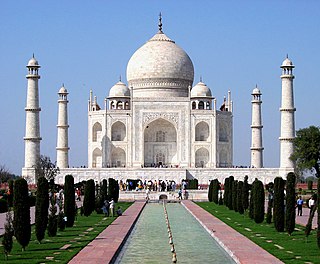
Indo-Persian culture refers to a cultural synthesis present in the Indian subcontinent, characterised by the absorption or integration of Persian aspects into the various cultures of Pakistan, India and Bangladesh. The first large-scale introduction of Persian influence and culture to the Indian subcontinent was by Muslim rulers of Turkic and Afghan origin with Persianate societies and Persianised cultures. This socio-cultural synthesis arose steadily through the Delhi Sultanate from the 13th to 16th centuries, and the Mughal Empire from then onwards until the 19th century. Various Muslim Turko-Persian rulers, such as the 11th-century Sultan Mahmud Ghaznavi, rapidly pushed for the heavy Persianization of conquered territories in northwestern India, where Islamic influence was also firmly established.

Hemu was a Hindu king who previously served as a general and Chief Minister of Adil Shah Suri of the Suri dynasty during a period in Indian history when the Mughals and Afghans were vying for power across North India. He fought Afghan rebels across North India from the Punjab to Bengal and the Mughal forces of Humayun and Akbar in Agra and Delhi, winning 22 battles for Adil Shah.

The Khalji or Khilji dynasty was a Turko-Afghan dynasty which ruled on the Delhi sultanate, covering large parts of the Indian subcontinent for nearly three decades between 1290 and 1320. Founded by Jalal ud din Firuz Khalji as the second dynasty to rule the Delhi Sultanate of India, it came to power through a revolution that marked the transfer of power from the monopoly of Turkic nobles to Afghans. Its rule is known for conquests into present day South India and successfully fending off the repeated Mongol invasions of India.

Medieval India refers to a long period of the history of the Indian subcontinent between the "ancient period" and "modern period". It is usually regarded as running between the breakup of the Gupta Empire in the 6th century AD and the start of the Mughal Empire in 1526, although some historians regard it as both starting and finishing later than these points.
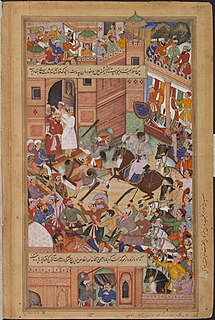
The Akbarnama, which translates to Book of Akbar, the official chronicle of the reign of Akbar, the third Mughal Emperor, commissioned by Akbar himself by his court historian and biographer, Abu'l-Fazl ibn Mubarak, called one of the "nine jewels in Akbar's court" by Mughal writers. It was written in Persian, which is the literary language of the Mughals, and includes vivid and detailed descriptions of his life and times. It followed the Baburnama, the more personal memoir by his grandfather, Babur, founder of the dynasty. Like that, it was produced in the form of lavishly illustrated manuscripts.
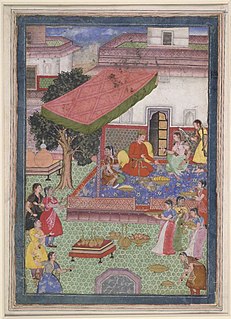
Zenana literally meaning "of the women" or "pertaining to women," in Persian language contextually refers to the part of a house belonging to a Hindu or Muslim family in the Indian subcontinent which is reserved for the women of the household. The zenana are the inner apartments of a house in which the women of the family live. The outer apartments for guests and men are called the mardana. Conceptually in those that practise purdah, it is the equivalent in the Indian subcontinent of the harem.

Muslim conquests in the Indian subcontinent mainly took place from 12th to 16th century, though earlier Muslim conquests include the invasions into modern Pakistan and the Umayyad campaigns in India, during the time of the Rajput kingdoms in the 8th century.
ShaikhAbu al-Faiz ibn Mubarak, popularly known by his pen-name, Faizi was a poet and scholar of late medieval India whose ancestors Malik-ush-Shu'ara of Akbar's Court. He was the elder brother of Akbar's historian Abul Fazl. Akbar highly recognised the genius in him and appointed him tutor for his sons and gave place to him among his decorative 'Navaratnas'.

Gulbadan Begum was a Mughal princess and the daughter of Emperor Babur, the founder of the Mughal Empire.
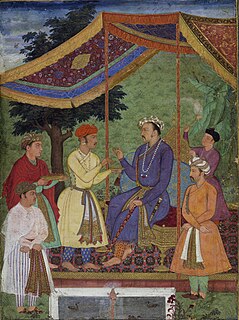
Khusrau Mirza was the eldest son of the Mughal emperor Jahangir.
Muzaffar Alam is the George V. Bobrinskoy Professor in South Asian Languages and Civilizations at the University of Chicago.

Abu'l-Fath Jalal-ud-din Muhammad Akbar, popularly known as Akbar the Great,, and also as Akbar I, was the third Mughal emperor, who reigned from 1556 to 1605. Akbar succeeded his father, Humayun, under a regent, Bairam Khan, who helped the young emperor expand and consolidate Mughal domains in India.

The Mughal, Mogul or Moghul Empire, was an early modern empire in South Asia. For some two centuries, the empire stretched from the outer fringes of the Indus basin in the west, northern Afghanistan in the northwest, and Kashmir in the north, to the highlands of present-day Assam and Bangladesh in the east, and the uplands of the Deccan plateau in south India.
Professor Simon Everard Digby MA was an English oriental scholar, translator, writer and collector who was awarded the Burton Medal of the Royal Asiatic Society and was a former Fellow of Wolfson College, Oxford, the Honorary Librarian of the Royal Asiatic Society and Assistant Keeper in the Department of Eastern Art of the Asmolean Museum in Oxford. He was also the foremost British scholar of pre-Mughal India.

Chhan is a village in the Sawai Madhopur district of Rajasthan, India. It is identified with Jhain, which is mentioned in the Delhi Sultanate chronicles as an important town of 13th and 14th century India.















